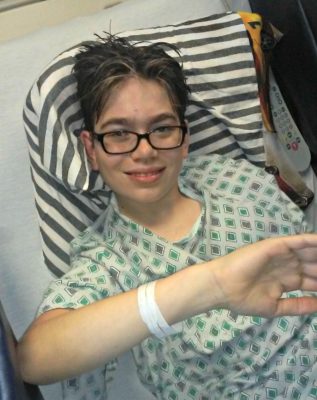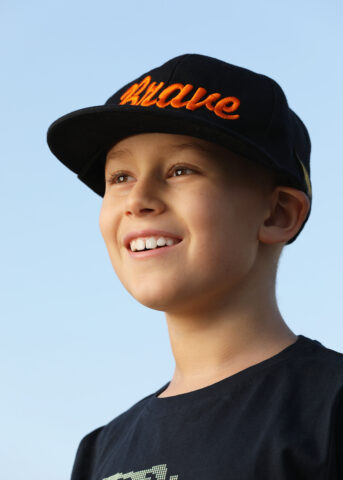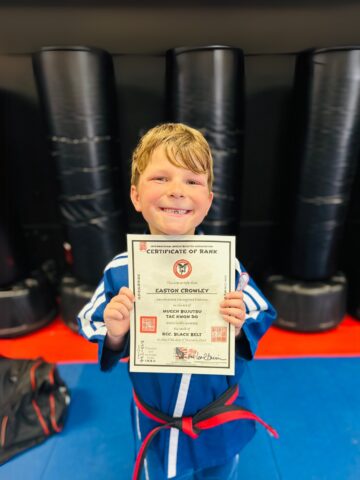Thick blankets covered the tables in Joe and Nicole Lucak’s New Mexico home to protect their young son who was living with epilepsy. The couple placed a soft cloth over every surface to protect their son Gabriel when he’d suffer a seizure and fall.
On bad days, Gabriel would experience up to 50 seizures. On a good day, it might be just 10. On any day though, this reality was devastating for his parents.
“It was like living out a surreal nightmare,” Nicole says.
Gabriel had been a healthy, normally developing child until age 3, when he experienced his first tonic-clonic seizure, the type of seizure typically depicted in movies when a person first loses consciousness, then falls to the ground and begins jerking and shaking.
Searching for answers
Gabriel was initially diagnosed at his local hospital with myoclonic-astatic epilepsy, also known as Doose syndrome. His seizures were difficult to control, and doctors attempted many different treatments, including eight months on a special ketogenic diet. During this time, Gabriel was hospitalized numerous times to modify his medication and control his seizures.
A low point for the Lucak family came about nine months after the seizures began. While hospitalized for respiratory syncytial virus, Gabriel’s seizures increased significantly. An electroencephalogram (EEG) recorded seizures occurring about once a minute and a slowing brain wave frequency. Magnetic resonance imaging (MRI) revealed decreased brain volume. Gabriel’s health was rapidly deteriorating.
Joe and Nicole desperately began looking elsewhere for help, and found a beacon of hope nearly 1,400 miles away in Dr. Mary Zupanc, a CHOC pediatric neurologist and one of the nation’s leading epileptologists, who was practicing in Wisconsin at the time.
Under Dr. Zupanc’s care, Gabriel began a new treatment program. He stopped following the ketogenic diet and began taking a new antiepileptic medication. He underwent a two-week long-term video EEG monitoring study, which revealed he was experiencing a fifth type of seizure during sleep.

A new diagnosis
Dr. Zupanc then knew that Gabriel’s epilepsy had evolved into a more severe form called Lennox-Gastaut syndrome (LGS). This rare type of epilepsy is marked by seizures that are difficult to control, and typically persist through adulthood.
She also diagnosed Gabriel with cerebral folate deficiency, a rare metabolic condition, following a spinal tap and extensive testing on his cerebral spinal fluid. He immediately began taking a folinic acid supplement and following a strict dairy-free diet.
Under this new treatment plan, Gabriel was seizure-free within two months. A second spinal tap showed a normal level of folate, and another MRI had normal results. The Lucaks were thrilled.
“Gabriel could have suffered severe brain damage, or he might not have survived at all,” Nicole says. “That’s how critical it was for us to have found Dr. Zupanc when we did.”
A bright future
Today, Gabriel is an intelligent, creative and artistic 13-year-old who dreams of being a paramedic when he grows up.
After regularly traveling from San Diego, where the family now lives, to the CHOC Neuroscience Institute and its level 4 epilepsy center for appointments and follow-ups, Gabriel has had several normal EEG studies and has successfully weaned off his anti-epileptic medication with no seizures.
Because of this, Dr. Zupanc believes Gabriel’s epilepsy is in remission. Now, he no longer needs to always carry emergency medication – a development that is life-changing for Gabriel and his family.
“All restrictions and seizure precautions have been lifted,” Nicole says. “So, Gabe looks forward to driver’s education in the near future. He will no longer need to have long-term video EEG monitoring performed each year. No more medical ID necklace. No more Diastat in my purse. No more Diastat kit in the school’s health room.”
Gabriel is also under the care of Dr. Jose Abdenur, chief of CHOC’s metabolics disorders division. Gabriel, his younger brother and his parents have all participated in several research studies involving genetic testing for both epilepsy and cerebral folate deficiency. Results of the epilepsy study found no predisposition to epilepsy.
Get more expert health advice delivered to your inbox monthly by subscribing to the KidsHealth newsletter here.

Learn more about CHOC’s Neuroscience Institute
CHOC Hospital was named one of the nation’s best children’s hospitals by U.S. News & World Report in its 2024-25 Best Children’s Hospitals rankings and ranked in the neurology and neuroscience specialties.





